#AV1codec
Explore tagged Tumblr posts
Text
Sine Damno Educendi

youtube
I recently ran into a problem with how one of my video editing programs imports a specialized audio track, specifically engineered to deal with YouTube’s compression algorithm when you upload videos to the platform. It should be known that YouTube compresses both video and audio from its original sampling rate once a video is processed through the upload system. The program I was working with was Pinnacle Studio 24 from Corel. Some projects go smoothly. Others send you on a wild goose chase, digging through software settings, running test after test, and questioning your life choices. This is the story of the latter—a deep dive into the frustration of handling audio files and the long road to finding a way around limitations of how some software’s handle importing tracks. If you’ve ever imported a crisp, professional-grade audio track into a video editor only to have the final export sound dull and lifeless, you’re not alone.
This issue wasn’t immediately obvious. In fact, it took an outside ear to even catch it. An audio engineer—someone with a much sharper sense of sound than I have—noticed something was wrong. The higher frequencies, the "top end" of the audio, were being cut off in the final export. The mix sounded fine on my editing timeline, but something was happening during the rendering process. What followed was a multi-layered, 3-day, troubleshooting process, leading to some surprising (and infuriating) discoveries about how Pinnacle Studio handles audio tracks.
Step 1: Confirming the Problem:
The first clue that something was off came before I even uploaded the video to YouTube. The song, originally a rich and balanced .wav file, suddenly sounded like it had been run through a low-pass filter. The shimmer of cymbals, the brightness of the vocals, and the overall clarity were gone.
At first, I assumed it was YouTube’s infamous compression. It’s well known that YouTube processes uploaded videos with its own audio compression algorithms, sometimes reducing quality. But even playing back the exported file before uploading revealed the same issue—YouTube wasn’t the only problem. Pinnacle Studio itself was altering the audio. Both on the import into the program and the rendered export of the finished product.
Step 2: Checking the Import Settings:
One of the most overlooked steps in video editing is how your software imports media. Most people assume that dragging and dropping a file into the timeline means it stays in its original format. Unfortunately, that’s not always the case.
Pinnacle Studio doesn’t have the most transparent way of handling audio files. While it can work with .wav files, the way it processes them internally is another story. There was no obvious warning that my high-quality, uncompressed audio was being altered upon import, but I had my suspicions.
To test this, I tried playing the original .wav file outside of Pinnacle in a separate audio player. It sounded perfect. Then, I played the same file within Pinnacle’s timeline. It still sounded fine. But after exporting? That’s where the trouble began. The import settings are defaulted and cannot be changed directly for just an audio tract. One usually sets up the project parameters and Pinnacle will treat the files based on their presets on how one sets up the parameters. While no direct compression was detected. I went ahead and went into all the audio effects and made sure if anything was added automatically, that they were removed and the audio track was locked down after that. I do not know for sure if this does anything or not but I was able to delete some settings added to the track when I clicked on corrections. However, I believe nothing was added that made a direct difference. Only a placeholder for a change was in the settings and I just clicked on the garbage can to remove it in the case any changes were made. When I played the track before and then after I did not see or notice any changes. This made me think it had to be the output settings.
Step 3: Tweaking Pinnacle’s Export Settings:
If importing wasn’t the issue, maybe it was the export process. Pinnacle Studio 24 has multiple export presets, and many of them apply compression by default. By default, it exports in AAC audio format, which, while decent, applies lossy compression. Lossy compression is fine for casual videos, but not when you need to preserve the full depth of a professionally mixed music track.
I started tweaking settings.
First, I tried exporting in .mp4 with the highest available audio bitrate. No change.
Then, I tried different sample rates and bit depths. Still no change.
Finally, I tried exporting in .mkv, just to see if that made a difference. It didn’t. it actually crashed Pinnacle every time I tried to run the export as .mkv.
At this point, I was convinced that Pinnacle was doing something to the audio that wasn’t obvious in its settings. Pinnacle in general is a massive black hole on system resources on a windows computer. Memory (RAM), Graphics Card (GPU) are working so hard my whole system is almost crippled by the usage. I have an old computer and it’s very possible my installation of Pinnacle on this machine is too much a strain for the system to work as it’s supposed to work. I have to shut down most of my computer programs, and web browsers in order to run Pinnacle smoothly.
Step 4: The Hidden Culprit – Pinnacle’s Audio Presets:
Digging deeper into Pinnacle’s settings, I discovered something frustrating: Pinnacle Studio 24 applies audio compression and EQ settings by default. As I discussed before this was nice to find and know it was adding something to my audio track, but not enough to make that the main reason the problem existed in the first place. These aren’t listed as part of the export settings, but rather buried in the "Corrections" tab under audio adjustments.
There, I found an automatic preset subtly altering the sound. Deleting these presets improved the clarity, but the issue still wasn’t entirely gone. Pinnacle was still rendering the audio in a way that affected the high frequencies.
Step 5: A Workaround – Enter VSDC:
If Pinnacle wasn’t going to let me export a clean audio track, I needed another solution. That’s where VSDC came in. VSDC is a free, non-linear video editor that offers more control over export settings, especially for audio. Instead of fighting Pinnacle, I decided to take a different approach. I had been using VSDC a lot more than Pinnacle in the past few months. VSDC can do a lot of things Pinnacle cannot do. However, Pinnalce’s interface is a little easier to work with for this type of work. I have yet to really learn VSDC to a point where this is what I always use. I have been a Pinnacle Systems-guy since the year 2000. I have used many other PC-based editors but I always stuck with Pinnacle. Its only been recently that I have been using VSDC. I began using it for its audio spectrum abilities but then I learned VSDC have many options for exporting videos using different presets and being able to customize those presets in a much more refined and detailed way:
Export the video from Pinnacle Studio 24 with the best possible visual settings but accept the slightly degraded audio.
Import the exported video into VSDC and replace the audio track with the original .wav file.
Export the final version in VSDC using lossless PCM S16LE audio encoding.
This method allowed me to bypass Pinnacle’s internal audio processing while still using it for its video editing capabilities. The results? A massive improvement. The final export retained the original high frequencies and overall clarity of the song.
Step 6: Uploading to YouTube – The Final Test:
Even after fixing the problem on my end, there was still the matter of YouTube’s own compression. Some degradation is unavoidable when uploading to YouTube, but I wanted to minimize it as much as possible.
Through further research and testing, I found that YouTube applies less aggressive compression to videos exported in .mkv format with PCM audio. While .mp4 is the most common format for YouTube uploads, it often triggers heavier compression, especially on the audio side. By exporting in .mkv with PCM S16LE audio compression, I managed to retain far more of the original sound quality after uploading. The difference wasn’t night and day, but it was enough to be noticeable, especially to those with trained ears.
There were several triggers I needed to understand with how VSDC allows the user to edit its export settings. First, I had to choose this is an export for a computer file. Not necessarily, for YouTube or social media but an export for my computer. Second, I had to choose .mkv as the export settings. Third, I then could tweak the audio compression export settings. Doing it this way tells VSDC to unlock more encoders to choose from. When choosing say YouTube as an .mp4 it only allows AAC to choose from. What we wanted here was PCM. I cannot access PCM from the dropdown unless I choose the output as for my computer, as a .mkv, then I am able to choose PCM from choices of audio compression encoders. I could probably find a way to edit this so that I can use them all in any format-presets, but I am not nearly as crafty about this as I’d like to be. Plus, it’s of no real consequence here. The point is I needed to be able to export the video in full HD with this audio encoding feature in order to trick YouTube to not compress as much on this file over other uploads.
Final Thoughts – Lessons Learned:
This entire experience was a reminder of how complex audio handling can be in video production along with all the issues that can and most of the time will arise within a given project and the resource demands on one’s system. Even with high export settings, Pinnacle Studio applied hidden audio processing that degraded quality in ways I didn’t expect. Along with its limited control over specific output settings. It took three days of research, watching videos on the subject, having dialog with AI, trial and error, overnight renders, and format tests to pinpoint the problem—and the solution.
VSDC proved to be a critical tool for final audio processing, allowing me to replace the degraded track while keeping the video quality intact. YouTube also handled audio better with .mkv using PCM S16LE, which made a noticeable difference in the final upload. While I originally used VSDC as a workaround in this case, it’s clear this program is more modernized on how video and audio are handled inside the program, how the tools work with your system and efficient in handling certain tasks that Pinnacle struggles with.
This reinforced a simple truth: —no software is perfect. Pinnacle has served me well for decades, but its hidden processing, resource-heavy nature, and age of the software made this project more complicated than it needed to be. In contrast, VSDC runs smoother, is far less resource intensive, and allows me to keep multiple programs open without taxing my system. While my working knowledge of it isn’t strong enough to fully replace Pinnacle yet, I’ll been integrating it more into my workflow with smaller projects and will be using VSDC more moving forward. At the end of the day, video editing is as much about problem-solving as it is about creativity. Never assume your software is handling things exactly the way you want—test, experiment, and be ready to pivot. For now, the music video is finished, the audio is intact, and the lesson is learned.
Sine Damno Educendi Latin for: (Exporting Without Loss) by David-Angelo Mineo 3/16/2025 1,965 Words
#videoediting#audioquality#youtubecompression#pinnaclestudio24#ffmpeg#av1codec#vp9codec#pcmaudio#wavaudio#bitrateoptimization#videoexportsettings#highqualityaudio#losslessexport#youtubeaudiocompression#pcms16le#youtubeuploadsettings#bestyoutubeformat#videoproduction#digitalaudioquality#streamingquality#writersuniverse#writerswrite#writers#writerscommunity#writerslife#blogger#bloggers#bloggerstyle#bloggerlife#blog
0 notes
Text
Elevate Your Experience: Radeon Pro W7700 and AMD Graphics Advanced

Graphics Advanced on which Radeon Pro W7700 by AMD’s processor
Graphics Advanced on which Revolutionize your routine with Ryzen 7700 paired with AMD’s Graphics Advanced. This daily comparison delves into the excellence of AMD’s mid-range workstation graphics cardby AMD’s processor In terms of daily use, how does AMD’s mid-range workstation graphics card compare? Using disassembly and material analysis
AMD has finally completed its own line of RDNA3 graphics cards for practical usage with the Radeon Pro W7700, narrowing the significant difference between the previously evaluated Radeon Pro W7800 and W7600. The purpose of today’s test is to examine this chip’s usability in productive applications, even if its design as a gaming graphics card would slot it nicely between a Radeon RX 7600 and the RX 7700XT.
Naturally, he will unable to provide street costs since availability in Germany is still quite limited. Therefore, it is reasonable to infer that even the RRP may still be marginally below (or slightly over) the 1000 euro threshold. Given that you can contrast the card with many equivalents from the NVIDIA universe, that’s quite the claim.
Because you really need to distinguish reasonably between regions where the Radeon Pro W7700 truly works well and others where the image is pretty muddled, you may find out precisely where you end up in the conclusion. Driver improvements may be performed in this area as well over time, but just the status quo as of right now is relevant; the remainder can be verified later.
Where is this card seen by AMD?
AMD has finally filled the enormous gap in its own portfolio with the Radeon Pro W7700, the newest graphics card in the Radeon PRO series for workstation PCs. Despite its comparatively modest price, this mid-range model of the next generation card promises to give remarkable performance in the fields of AI and CAD. AMD claims that the W7700 delivers an exceptional price/performance ratio, with its RDNA 3 architecture and 16 GB GDDR6 RAM being 1.7 times greater than that of its predecessors.
For designers and other creative professionals looking to enhance their workflows in programs like Solidworks, Adobe Premiere, or Da Vinci Resolve, The Radeon Pro W7700 was created specifically. Its performance may reach up to 28 TFLOPS (in FP32 values), and its 48 compute units (CUs) and matching number of ray accelerators make it suitable for ray tracing jobs. It also has AMD’s new Radiance Display Engine, which allows projects on up to four screens to have stunning resolutions and vibrant color depths.
Therefore, it seems that professionals searching for a robust but reasonably priced graphics card for demanding applications like CAD and AI may choose the Radeon Pro W7700. According to AMD, it’s a compelling choice among workstation graphics cards because of its cutting-edge technology, excellent performance, and affordable pricing. he also tried complete versions of Adobe Creative Cloud, Solidworks, Creo, and other programs to confirm this; however, more on that in a bit.
Details about the Radeon Pro W7700
The card with the chrome applications and the black light metal clothing seems larger than it really is. Alright, the radial fan blower design automatically contributes to weight savings, resulting in the scales showing just 833 grams in the end. That’s fine for a card that is 24.2 cm long.
With no backplate, the card has a genuine dual-slot design and a net thickness of 3.5 cm (or 3.8 cm when the rear screws and clamping cross are included). The usual installation height of 10.5 cm is determined by the slot panel. The card’s end has a standard 6 2 pin connection for power supply, eliminating any need for cords to obstruct the installation process.
The slot bracket has four DisplayPorts 2.1 in total, which is really adequate for all scenarios in the places where the card positions itself, in addition to the air outlet apertures required for the DHE concept of the card. Naturally, this also rubs a little salt in NVIDIA’s wounds, as Ada generation workstation graphics cards still use DisplayPort version 1.4, which has much lower throughput. With “only” half the RAM and half the CUs of the W7800, it is more of a mid-range card in the new Radeon PRO series; nonetheless, given its price, many professional users would find it to be an appealing alternative.
AI speedup and compatibility for the AV1 codec:
For effective encoding procedures, the Radeon Pro W7700 supports the AV1 codec and provides hardware-based AI accelerators. This is particularly helpful for programs like Adobe Premiere and DaVinci Resolve that gain from AI improvements.
Read more on Govindhtech.com
#Radeon#ProW7700#RX7600#RX7700XT#RDNA3#AMD#graphiccards#GDDR6RAM#NVIDIA#DisplayPorts#AI#AV1codec#technews#technology#govindhtech
0 notes
Text
New technologies in Samsung TVs 2020 Review
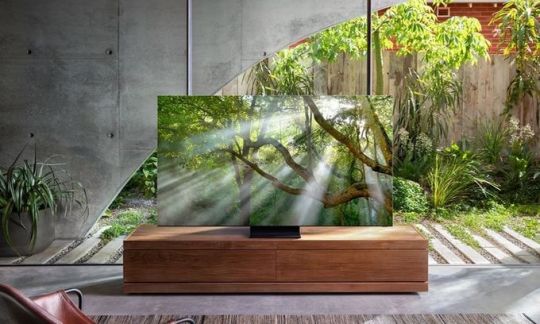
As known, these days companies present their new products at CES 2020. As usual, the attention of experts is primarily attracted by the leaders of the consumer electronics segment, which shape development trends. Of course, Samsung is one of them. The company fully met expectations by presenting three new TVs, including the second generation of Samsung 8K model, innovative MicroLED panels and the experimental The Sero TV. It has a rotary screen for viewing video content in vertical format, for example, from Instagram.

Of course, Samsung Q950TS aroused the greatest interest among experts. In fact, the company created the second generation of its 8K TV.
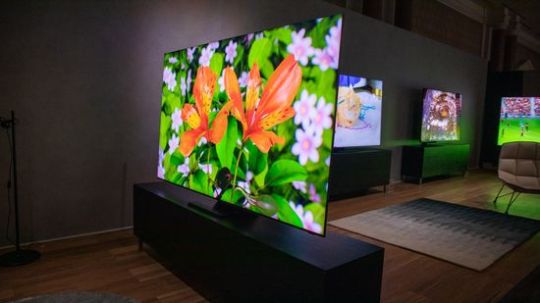
The company demonstrated that the past year was not in vain, embodying a huge number of innovative solutions in the Q950TS. Moreover, this model demonstrated the company's successes in fundamental directions, including 8K AI upscaling based on Deep Learning with neural network and AI ScaleNet technology.
Upscaling
As known, upscaling increases the number of pixels in the original signal to increase the image clarity on the TV screen. This problem arose about 10 years ago when TVs already provided Full HD (1920 x 1080) resolution, and television channels broadcast the signal in HD format (1280 x 720), or SD format (480p, 576i). Of course, this factor significantly reduced the advisability of buying an expensive Full HD TV. At the first stage, companies successfully solved this problem, showing in advertising or when selling a magnificent image of high-quality video with high resolution. But having bought such a TV, the consumer was quickly disappointed due to the low image quality of low-resolution video from normal traffic. Very quickly, the consumer market realized that even a very expensive TV can provide high quality only when playing high-quality content. Of course, companies could wait for the required content to appear on the market, but there was a risk. For example, many people remember the rise and sunset of the 3D format in TVs. Even with a large number of fans, today almost all companies have abandoned this option due to the shortage of 3D video content. As a result, large companies, including Samsung, began to actively develop upscaling technologies for their models, reducing their commercial risks. Indeed, even in the absence of appropriate native content, upscaling provides at least an increase in the quality of available low-resolution content, stimulating the acquisition of expensive model. As a last resort, 8K TV with high-quality upscaling will improve the playback quality of accessible content.
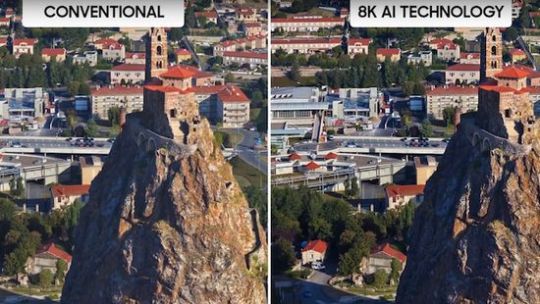
8K AI upscaling with AI Quantum Processor 8K
Physically, upscaling is similar to frame interpolation. As known, in this mode TV creates an additional intermediate frame based on two neighboring frames, ensuring smooth playback of even highly dynamic scenes. Accordingly, upscaling forms additional pixels to increase resolution. For example, the AI 8K Quantum easily scales content to 33,177,600 pixels. Unfortunately, upscaling can distort the original image, forming artifacts. Therefore, this task requires solving many complex problems, including color accuracy, GPU performance for video processing without lags, etc. As a result, companies developed a lot of upscaling technologies, including Pixel Shift (formation of an additional pixel by shifting), bicubic interpolation (calculation colors by adjacent pixels), etc. Today, AI upscaling is the most promising direction. The Q950TS confirms Samsung’s leadership in the AI upscaling.
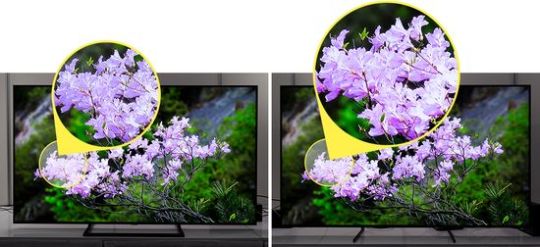
This model uses the latest generation of the AI Quantum Processor 8K, which extends AI upscaling capabilities. Previously, AI machine learning used a formula bank, which is downloaded to the TV and updated periodically. New Q950TS supports innovative Deep Learning using a neural network to expand machine learning. In fact, it creates its own formulas and algorithms without using a formula bank. Of course, Deep Learning has become a quality leap in AI processing. It is performed on a per-pixel basis with the use of noise reduction, restoration of contours, texture creation and restoration of small details. Deep Learning is primarily intended for small details and complex images.
AI ScaleNet
Of course, transmitting 8K streaming video content requires a significant increase in the bandwidth of communication channels, which depends on the speed of your Internet connection. To solve this problem, Samsung Research Visual Technology has developed a new AI ScaleNet video codec. As its name implies, the company uses AI to decompress 8K video. In fact, 8K is compressed to 4K using AI-downscaler and transmitted to the user's TV. Then, AI ScaleNet (codec with machine learning elements using different patterns for different image parts) restores 4K to 8K.
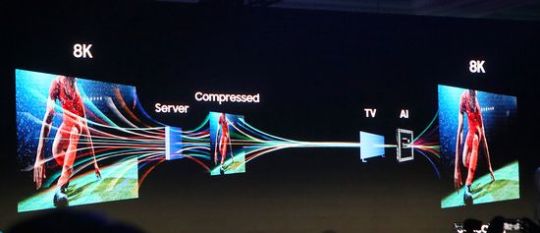
Kwang Pyo Choi, developer of this codec, said that AI ScaleNet uses AI Adaptive Bit Rate Streaming, which provides adjustment depending on the bandwidth of the networks. In fact, the codec adjusts the resolution for smooth video streaming. In prospect, this technology will provide the required quality of 8K content transfer even at low bandwidth, for example, during periods of heavy network traffic. Moreover, Samsung has agreed with Amazon Prime Video to jointly test the new technology. Additionally, the Q950TS supports Google's AV1 (AOMedia Video 1) codec for 8K YouTube content.
Object Tracking Sound Plus (OTS+), Active Voice Amplifier (AVA) and Q Symphony
Apparently, Samsung paid a lot of attention to the object-oriented audio, which lies at the heart of Dolby Atmos and DTS: X. As a result, the new TV has OTS+ (Object Tracking Sound Plus) technology that recognizes moving object inside the scene. After identifying the object, OTS+ moves the corresponding sound track in the direction of its movement using internal speakers. As a result, the sound follows the object. This effect works well, for example, in the scene of a passing car or flying helicopter. TV sequentially switches the speakers, creating a wonderful illusion of the engine sound that moves with the car or helicopter. Maybe Object Tracking Sound Plus is not yet ready to compete with Dolby Atmos, but, of course, it significantly surpasses the traditional 10W down-firing speakers in other flagships. In addition, the company offers AVA (Active Voice Amplifier) feature that adjusts the volume of dialogs depending on the noise level in the room. For example, when using a blender or vacuum, AVA will automatically increase the volume. But in case of a conversation in the room, the AVA activation requires pressing a passive-aggressive button on the remote control. Most likely, Q-Symphony technology will appeal to home theater enthusiasts. It combines the speakers in the Samsung TVs of 2020 and Samsung Q800T soundbars into a single audio system, creating a stunning dynamic soundscape. In fact, Q-Symphony creates a 9.1.4 configuration.
Conclusion
Samsung has once again confirmed its innovative leadership. New Samsung Q950TS 8K TV, innovative MicroLED panels and the experimental The Sero TV demonstrated that the company's engineers were able to make significant progress in a year. The Q950TS 8K TV has embodied almost all of the company's innovative solutions, including 8K AI upscaling with AI Quantum Processor 8K, AI ScaleNet, Object Tracking Sound Plus (OTS+), Active Voice Amplifier (AVA) and Q Symphony. In fact, Q950TS became the best advertisement of the innovative successes of a South Korean company. Apparently, Samsung Q950TS 8K will compete with Nano99, Nano97 and Nano95 series of LG NanoCell 8K TVs and Sony Z8H 8K. The video offers a demo of the Q950TS 8K and Sero Vertical TV at CES 2020. Read the full article
#8KAIUpscaling#ActiveVoiceAmplifier#AIQuantumProcessor8K#AIScaleNet#AOMediaVideo1#AV1codec#bicubicinterpolation#DeepLearningwithneuralnetwork#ObjectTrackingSoundPlus#PixelShift#QSymphony#SamsungQ950TS8K
0 notes
Text
Samsung TVs 2020 Review
As known, these days companies present their new products at CES 2020. As usual, the attention of experts is primarily attracted by the leaders of the consumer electronics segment, which shape development trends. Of course, Samsung is one of them. The company fully met expectations by presenting three new TVs, including the second generation of Samsung 8K model, innovative MicroLED panels and the experimental ‘The Sero’ TV with a rotary screen for viewing video content in vertical format, for example, from Instagram.
Samsung MicroLED TVs
As known, Micro LED is an innovative technology of self-emitting display, and can be positioned as an analogue of OLED technology. Today, Samsung dominates in this direction. At ISE 2018 the company first introduced the modular large-format The Wall Professional Micro LED display in 146- or 219-inch versions with brightness up to 2000 nits. Then, at CES 2019, Samsung introduced a more compact 75-inch 4K MicroLED TV. In the summer of 2019, the company announced a new The Wall Luxury MicroLED TV with a diagonal of 292 inches (almost 7.5 meters), support for 8K resolution and with a brightness of up to 2000 nits. This year, the company announced 88- and 150-inch bezel-less MicroLED TVs with custom settings. According to the company, their brightness reaches an unprecedented 5,000 nits. For comparison, the brightness of modern OLED TVs does not exceed 1000 nits. Thus, today the list of diagonals Samsung MicroLED The Wall series includes 75, 88, 93, 110, 146, 150, 219 and 292 inches. Of course, the modular design provides excellent prospects for this technology. Over time, it will allow the user to create TV with a screen of any shape and size, including non-traditional formats. In addition, Samsung MicroLED TV optimizes video content for any screen, increasing its resolution at a constant pixel density. Moreover, MicroLED screens support any aspect ratio without compromising image quality. At CES 2019, the company demonstrated MicroLED modules and their assembly using brackets that are attached to the screen with sufficiently powerful magnets. The diagonal of one module does not exceed 13 inches.
The Sero TV
The company also did not ignore the growing popularity of the use of smartphones for shooting and viewing video content. According to research, 70% of millennials don't turn their phone horizontally to watch videos. As a result, the company's management decided to develop a vertical OLED TV targeted at the millennials and Generation Z. In 2019, Samsung announced the unconventional Sero Vertical TV. At CES 2020, the company introduced the 43-inch 4K Sero model. Thanks to a special stand, the display rotates from landscape mode to portrait mode for comfortable playback of video content from Instagram, Snapchat, etc. In addition, it can be synced with the phone via NFC to mirror the phone's display.
Samsung Q950TS 8K
Of course, Samsung Q950TS aroused the greatest interest among experts. In fact, the company created the second generation of its 8K TV. As known, last year the company introduced the Q900R 8K series with a diagonal of 65, 75 , 82, 85 and 98 inches. The 75-inch model of this series competed with LG 8K Nanocell 75SM9970. These models belong to approximately the same class, and their cost reached $ 6,000 and $ 5,000, respectively. In addition, LG introduced the LG 8K OLED88Z9, but its cost is approaching $ 30,000. Traditionally, OLED screens have many pros, but their price increases dramatically with increasing screen sizes. Today 75-inch Q950TS with 8K (7680 × 4320) resolution is one of the brightest among modern TVs. Its peak brightness reaches 4000 nits. The Q950TS uses a FALD (full array local dimming). As known, today it most effectively provides deep black gradations and brighter highlights with minimal blooming or haloing. Tentatively, the number of zones does not exceed 500. In addition, the company increased performance with Adaptive Peak Brightness. TV analyses a map of current image, defining bright or dark areas. Based on the analysis, it increases current for brighter areas and decreases - for darker parts. Other improvements require more detailed analysis. Samsung engineers demonstrated German pedantry, harmoniously improving almost all components, including design, processor, video processing algorithms, sound, modes and functions, etc. As a result, Q950TS embodied a huge number of innovative solutions. Moreover, this model demonstrated the company's successes in fundamental directions, including 8K AI upscaling based on Deep Learning with neural network and AI ScaleNet technology.
Conclusion
PROS - bezel-less Infinity Design; - high-quality 8K AI upscaling with AI Quantum Processor 8K; - impressive picture quality; - superior sonic performance with eight drivers (4.2.2-channel driver array); - incredibly low input lag up to 10 ms in Auto Game Samsung mode; - HDR support, including HDR10, HLG and HDR10+; - Deep Learning with neural network; - Ultra Viewing Angle; - Adaptive Picture, Adaptive Peak Brightness and Adaptive Tone Mapping; - Object Tracking Sound Plus (OTS+), Active Voice Amplifier and Q-Symphony; - AV1 (AOMedia Video1) codec for 8K YouTube. CONS - today OTS+ is inferior to Atmos; - no Dolby Vision or Atmos support. In general, the company has confirmed its status as one of the innovative leaders by introducing promising high-tech MicroLED TVs, experimental Sero TV and the magnificent Q950TS with a huge number of innovative solutions. Of course, the Q950TS will have to compete with LG NanoCell 8K TVs, which, like last year, includes the Signature OLED 8K and NanoCell 8K. Given the approximate price, the Q950TS and LG NanoCell 8K are likely to be in the same price segment. But regardless of the results of their rivalry, the real quality of the 8K AI upscaling based on Deep Learning with neural network and AI ScaleNet will be very interesting to users and experts. This video offers an overview of the Samsung Sero Vertical TV at CES 2020. Read the full article
#8KAIUpscaling#ActiveVoiceAmplifier#AdaptivePeakBrightness#AdaptivePicture#AdaptiveToneMapping#AIQuantumProcessor8K#AIScaleNet#AutoGameSamsungmode#AV1codec#DeepLearning#ObjectTrackingSoundPlus#OTS+#QSymphony#SamsungMicroLEDTVs#SamsungQ950TS8K#SamsungTVs2020#SeroTV#SeroVerticalTV
0 notes